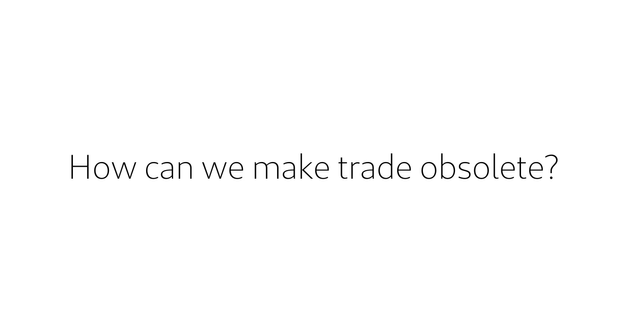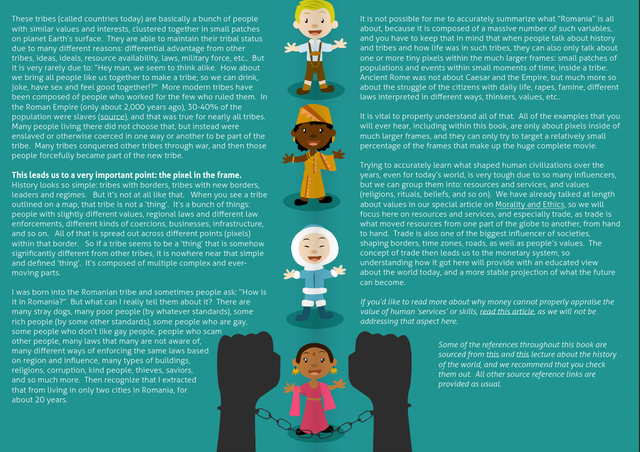The full snippet is here
All snippets are here
SNIPPETS
These videos are short snippets from our TROM materials, or newly created snippets based on external sources. The “negative” snippets are black, and the “positive” ones are white ;). This series is entirely managed by Aaron.
These tribes (called countries today) are basically a bunch of people
with similar values and interests, clustered together in small patches
on planet Earth’s surface. They are able to maintain their tribal status
due to many different reasons: differential advantage from other
tribes, ideas, ideals, resource availability, laws, military force, etc.. But
it is very rarely due to: “Hey man, we seem to think alike. How about
we bring all people like us together to make a tribe, so we can drink,
joke, have sex and feel good together!?" More modern tribes have
been composed of people who worked for the few who ruled them. In
the Roman Empire (only about 2,000 years ago), 30-40% of the
population were slaves (source), and that was true for nearly all tribes.
Many people living there did not choose that, but instead were
enslaved or otherwise coerced in one way or another to be part of the
tribe. Many tribes conquered other tribes through war, and then those
people forcefully became part of the new tribe.
This leads us to a very important point: the pixel in the frame.
History looks so simple: tribes with borders, tribes with new borders,
leaders and regimes. But it’s not at all like that. When you see a tribe
outlined on a map, that tribe is not a ‘thing’. It’s a bunch of things:
people with slightly different values, regional laws and different law
enforcements, different kinds of coercions, businesses, infrastructure,
and so on. All of that is spread out across different points (pixels)
within that border. So if a tribe seems to be a ‘thing’ that is somehow
significantly different from other tribes, it is nowhere near that simple
and defined ‘thing’. It’s composed of multiple complex and ever-
moving parts.
I was born into the Romanian tribe and sometimes people ask: “How is
it in Romania?” But what can I really tell them about it? There are
many stray dogs, many poor people (by whatever standards), some
rich people (by some other standards), some people who are gay,
some people who don’t like gay people, people who scam
other people, many laws that many are not aware of,
many different ways of enforcing the same laws based
on region and influence, many types of buildings,
religions, corruption, kind people, thieves, saviors,
and so much more. Then recognize that I extracted
that from living in only two cities in Romania, for
about 20 years.It is not possible for me to accurately summarize what “Romania” is all
about, because it is composed of a massive number of such variables,
and you have to keep that in mind that when people talk about history
and tribes and how life was in such tribes, they can also only talk about
one or more tiny pixels within the much larger frames: small patches of
populations and events within small moments of time, inside a tribe.
Ancient Rome was not about Caesar and the Empire, but much more so
about the struggle of the citizens with daily life, rapes, famine, different
laws interpreted in different ways, thinkers, values, etc..
It is vital to properly understand all of that. All of the examples that you
will ever hear, including within this book, are only about pixels inside of
much larger frames, and they can only try to target a relatively small
percentage of the frames that make up the huge complete movie.
Trying to accurately learn what shaped human civilizations over the
years, even for today’s world, is very tough due to so many influencers,
but we can group them into: resources and services, and values
(religions, rituals, beliefs, and so on). We have already talked at length
about values in our special article on Morality and Ethics, so we will
focus here on resources and services, and especially trade, as trade is
what moved resources from one part of the globe to another, from hand
to hand. Trade is also one of the biggest influencer of societies,
shaping borders, time zones, roads, as well as people’s values. The
concept of trade then leads us to the monetary system, so
understanding how it got here will provide with an educated view
about the world today, and a more stable projection of what the future
can become.
If you’d like to read more about why money cannot properly appraise the
value of human ‘services’ or skills, read this article, as we will not be
addressing that aspect here.
Some of the references throughout this book are
sourced from this and this lecture about the history
of the world, and we recommend that you check
them out. All other source reference links are
provided as usual.inventing currency
welcome new members
welcome
welcome new members
welcome
i am original
you?


Source
Copying and pasting previous posts or significant parts there of could be seen as spam when:
Spam is discouraged by the community and may result in the account being Blacklisted.
Please refrain from copying and pasting previous posts going forward. If you believe this comment is in error, please contact us in #disputes on Discord
Downvoting a post can decrease pending rewards and make it less visible. Common reasons:
Submit